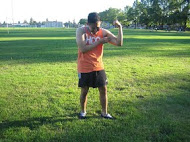Even though it might sound unusual, elbow pain linked with weightlifting is often the result of golfer’s elbow. Using incorrect techniques while an individual lifts weights can overload the muscles and tendons in the elbow, thus resulting to pain and tenderness on the interior of the joint and along the interior of the forearm. This is often accompanied by weakness in the wrist and hand, numbness or tingling in the fingers as well as stiffness or immobility of the affected elbow. There are a number of self-care measures that are suitable to manage this condition.
Adequate rest
An initial measure to manage the elbow pain is to instruct the individual to rest the affected elbow. Just remember that this does not necessarily mean that the individual has to stop lifting altogether. Instead of focusing on the upper body strength, the individual should focus on his/her legs until the elbow pain diminishes. Avoid lifting with the arms again until he/she can do so without triggering elbow pain. It is vital to stop right away if there is pain to avoid worsening the condition.

Application of ice
You can apply an ice pack over the affected elbow. The application of ice helps reduce the inflammation to any damaged tissue which reduces the pain. It is recommended to apply an ice pack on the elbow not more than 15-20 minutes at a time up to 4 times in a day. If the application is prolonged, it can actually worsen the condition.
Compression
The affected elbow should be compressed using an elastic bandage to reduce the pain. Just like with the application of ice, compression reduces the inflammation of the involved tissue which helps relieve the discomfort. On the other hand, it is best to continue to wrap the elbow even after the pain has already reduced, especially before lifting.
An elastic bandage can reduce the strain on the elbow, thus reducing the strain on the muscles, joints and tendons. Instead of using an elastic bandage, you can utilize a forearm strap to reduce the amount of load while lifting.
Consulting a doctor
The best way to prevent re-injury is to consult a personal trainer at a local gym. There is a possibility that the technique of the individual is to blame for the strain on the muscles and tendons of the elbow. By working with a trainer, any issues can be corrected especially on how to lift properly.
The trainer will teach the individual to maintain a rigid wrist position to reduce the load on the elbow. In addition, the trainer can also ease the individual back into his/her athletic pursuit by selecting activities that are not stressful on the elbows.
Stretching exercises
The individual can also benefit from stretching exercises that involve the muscles and tendons in the forearm and elbow. The wrist flexor stretch works by stretching the muscles utilized in lifting weights. The individual must extend the affected arm out in front with the palm facing the ceiling.
He/she must drop the wrist with the finger tips pointing toward the floor. Hold the fingers using the other hand and gently pull inwards. Hold the stretch for 30 seconds and then release. It is recommended to finish 5 repetitions.
